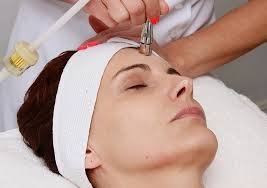Dermabrasion for acne scars
Dermabrasion for acne scars are conducted using local anesthesia at your doctor's clinic. A quickly spinning wire brush rubs the top layers of the skin. Following recovery, the appearance of scars has softened and pitted scars are decreased thoroughly. Dermabrasion is applied to manage depressed boxcar scarring. This particular method might make ice pick scars look more visible since while narrow at the skin's top, they usually broaden close to the bottom.
The face is one of the most
popular spot for therapy, however, other parts of the skin could be managed in
this way. Dermabrasion for acne scars is applied usually to enhance the look of acne scars and
fine lines surrounding the mouth. It also used to handle an enlarged nose
(rhinophyma) induced by rosacea, an inflammatory skin disease.
How it is performed

- The spots to be managed are cleansed and marked.
- A local anesthetic is normally applied to numb the skin prior to procedure, and ice packs are put on the skin for around Thirty Minutes.
- A freezing (cryogenic) spray can in some cases be used to solidify the skin for much deeper scrapes in the event that ice packs and the anesthetic do not help make the skin tough enough.
- For deeper abrasions, or when the whole
face is intending to be addressed, you might need more powerful general
anesthesia, sedation, anesthesia or pain killers.
- Just one smaller area at once is handled.
- The cold spray (in case ) is used for a couple of seconds and afterwards the spinning brush is used to remove the surface of skin.
- Bandage is
applied in order to avoid bleeding, and the part is covered with a clean
dressing or creams.
Dermabrasion is often performed in your physician's clinic or on an outpatient basis.
What To Expect After Surgery
Your healing and recovery
period following dermabrasion relies on the depth and size of the spot that was
addressed. An individual who has a full-face dermabrasion, for instance, will
likely have a much longer recovery period compared to someone who undergoes a
smaller area of skin treated. Deeper abrasions require much longer time to
heal.
- Generally, re-growth of
skin takes place within 5 to 8 days. This new skin is a red or pink color, that
normally vanishes within 6 to 12 weeks. Up until then, your regular
pigmentation can possibly be attained using make-up.
Most people have minimal or
zero pain and is able to return to their routine tasks right after the
treatment. Some individuals need painkiller. In case swelling happens, a
corticosteroid for instance prednisone might be applied to lessen the swelling.
Precaution following surgery
- Cleaning the skin many times a day to prevent infection and to eliminate the crusting that often appears.
- Replacing the creams or dressing on the wound to maintain the area moist and to enhance recovery.
- Staying
away from sun and, following peeling off has ended, apply sunscreen daily. New
skin is more prone to sun damage.
A number of follow-up
appointments to your physician might be required to check the skin's recovery
and re-growth and to detect and address early signs of infection or other
difficulties.
How Effectively It Works
The following factors influence the short-term and long-term outcomes of dermabrasion:
- Your skin type
- the situation of the skin
- your physician's level of knowledge
- the kind of brush employed,
- your standard of living following the treatment
Certain kinds of skin problems respond much better to dermabrasion compared to others. Individuals having lighter skin who restrict their sunlight exposure following the treatment have the tendency to much better outcomes than individuals with darker skin and those who remain to stay for a longer time in the sun.
Generally, dermabrasion for acne scars lead to a soft, smooth skin appearance and gives scarred skin a more consistent look.
Temporary side effects of dermabrasion for acne scars
- Scarring.
- Inflammation and redness. This normally vanishes in less than 6 to 12 weeks.
- Swelling.
- Bursts of acne. These can typically be managed effectively using tretinoin. Prescription antibiotics are in some cases required.
- Increased color in the skin. The skin in the region that was treated might become darker (hyperpigmentation) compared to the surrounding skin a number of weeks following dermabrasion.
- The
skins become highly sensitive to sunlight.
Home › Acne scar treatment › Dermabrasion for acne scars
Tags
ice pick scars, corticosteroid,
Irresistible Acne Remedies. This free newsletter is delivered monthly, straight to your INBOX. It covers all new pages since the last issue. Sign up here...


New! Comments
Have your say about what you just read! Leave me a comment in the box below.